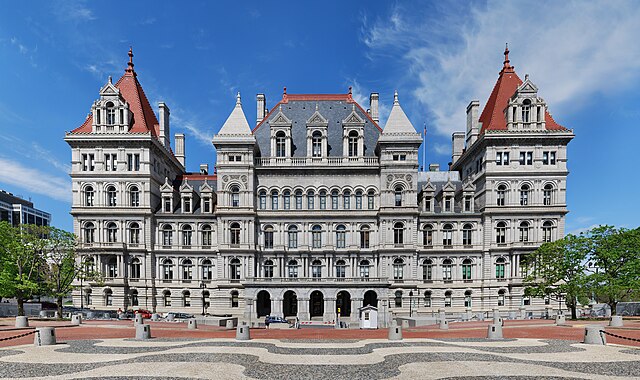Top Qs
Timeline
Chat
Perspective
137th New York State Legislature
New York state legislative session From Wikipedia, the free encyclopedia
Remove ads
The 137th New York State Legislature, consisting of the New York State Senate and the New York State Assembly, met from January 7 to May 20, 1914, while Martin H. Glynn was Governor of New York, in Albany.
Remove ads
Background
Under the provisions of the New York Constitution of 1894, re-apportioned in 1906 and 1907, 51 Senators and 150 assemblymen were elected in single-seat districts; senators for a two-year term, assemblymen for a one-year term. The senatorial districts were made up of entire counties, except New York County (twelve districts), Kings County (eight districts), Erie County (three districts) and Monroe County (two districts). The Assembly districts were made up of contiguous areas within the same county.
At this time there were two major political parties: the Republican Party and the Democratic Party. The Progressive Party, the Socialist Party, the Independence League and the Prohibition Party also nominated tickets.
Remove ads
Elections
The 1913 New York state election, was held on November 4. The only two statewide elective offices up for election were two judgeships on the New York Court of Appeals. Democrat Willard Bartlett was elected Chief Judge, and Republican Frank H. Hiscock was elected an associate judge, which had been cross-endorsed by the Independence League. The approximate party strength at this election, as expressed by the vote for Chief Judge, was: Democrats-Independence League 600,000; Republicans 597,000; Progressives 195,000; Socialists 62,000; and Prohibition 17,000.
Ex-Governor William Sulzer, who had been impeached, and removed from office in September 1913, was elected to the Assembly on the Progressive ticket.
Remove ads
Sessions
The Legislature met for the regular session at the State Capitol in Albany on January 7, 1914; and adjourned on March 28.[1]
Thaddeus C. Sweet (R) was elected Speaker with 81 votes against 48 for Al Smith (D) and 21 for Michael Schaap (P).[2]
John F. Murtaugh (D) was elected Majority Leader of the New York State Senate. At the same time, Robert F. Wagner (D) continued as president pro tempore of the State Senate and Acting Lieutenant Governor.
On February 25, the Legislature elected Homer D. Call (P) as New York State Treasurer, to fill the vacancy caused by the suicide of John J. Kennedy (D). Call was elected by a combination of Democrats and Progressives with 98 votes against 96 for Republican William Archer.[3]
The Legislature met for a special session at the State Capitol in Albany on May 4, 1914;[4] and adjourned on May 20.[5] This session was called because the Democratic Senate majority and the Republican Assembly majority were at odds over the State's budget, and did not approve the necessary financial appropriations during the regular session.
State Senate
Summarize
Perspective
Districts
- 1st District: Nassau and Suffolk counties
- 2nd District: Queens County, i.e the Borough of Queens
- 3rd, 4th, 5th, 6th, 7th, 8th, 9th and 10th District: Parts of Kings County, i.e. the Borough of Brooklyn
- 11th, 12th, 13th, 14th, 15th, 16th, 17th, 18th, 19th and 20th District: Parts of New York County, i.e. the Borough of Manhattan
- 21st and 22nd District: Parts of Bronx County, i.e. the Borough of the Bronx
- 23rd District: Richmond and Rockland counties
- 24th District: Westchester County
- 25th District: Orange and Sullivan counties
- 26th District: Columbia, Dutchess and Putnam and counties
- 27th District: Greene and Ulster counties
- 28th District: Albany County
- 29th District: Rensselaer County
- 30th District: Saratoga and Washington counties
- 31st District: Montgomery, Schenectady and Schoharie counties
- 32nd District: Lewis, Fulton, Hamilton and Herkimer counties
- 33rd District: Clinton, Essex and Warren counties
- 34th District: Franklin and St. Lawrence counties
- 35th District: Jefferson and Oswego counties
- 36th District: Oneida County
- 37th District: Chenango, Madison and Otsego counties
- 38th District: Onondaga County
- 39th District: Broome and Delaware counties
- 40th District: Cayuga, Cortland and Seneca counties
- 41st District: Chemung, Schuyler, Tioga and Tompkins counties
- 42nd District: Ontario, Wayne and Yates counties
- 43rd District: Steuben and Livingston counties
- 44th District: Allegany, Genesee and Wyoming counties
- 45th and 46th District: Monroe County
- 47th District: Niagara and Orleans counties
- 48th, 49th and 50th District: Erie County
- 51st District: Cattaraugus and Chautauqua counties
Members
The asterisk (*) denotes members of the previous Legislature who continued in office as members of this Legislature.
Note: For brevity, the chairmanships omit the words "...the Committee on (the)..."
Employees
- Clerk: Patrick E. McCabe
- Sergeant-at-Arms: Henry W. Doll
- Stenographer: William F. MacReynolds
Remove ads
State Assembly
Summarize
Perspective
Note: For brevity, the chairmanships omit the words "...the Committee on (the)..."
Assemblymen
Employees
- Clerk: Fred W. Hammond
- Sergeant-at-Arms: Harry W. Haines
- Principal Doorkeeper: Fred R. Smith
- First Assistant Doorkeeper: James B. Hulse
- Second Assistant Doorkeeper: Michael Kehoe
- Stenographer: Henry C. Lammert
- Postmaster: James H. Underwood[7]
Remove ads
Notes
Sources
Wikiwand - on
Seamless Wikipedia browsing. On steroids.
Remove ads

